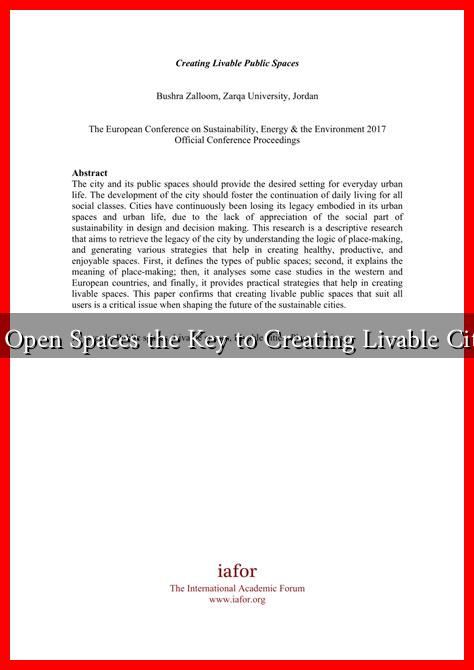-
Table of Contents
Are Open Spaces the Key to Creating Livable Cities?
As urbanization continues to rise, the need for livable cities has become more pressing than ever. Open spaces, such as parks, gardens, and plazas, play a crucial role in enhancing the quality of urban life. This article explores the significance of open spaces in creating livable cities, supported by research, case studies, and statistics.
The Importance of Open Spaces
Open spaces are essential for various reasons, including environmental, social, and economic benefits. They serve as the lungs of a city, providing essential green areas that contribute to the overall well-being of its inhabitants.
- Environmental Benefits: Open spaces help mitigate urban heat, improve air quality, and support biodiversity. According to a study by the National Institutes of Health, urban green spaces can reduce temperatures by up to 5 degrees Celsius.
- Social Benefits: Parks and recreational areas foster community interaction and social cohesion. A report from the American Planning Association indicates that neighborhoods with accessible parks have higher levels of social engagement.
- Economic Benefits: Open spaces can increase property values and attract businesses. A study by the Center for American Progress found that homes near parks can sell for 20% more than those further away.
Case Studies: Successful Open Space Initiatives
Several cities around the world have successfully integrated open spaces into their urban planning, demonstrating the positive impact these areas can have on livability.
1. New York City’s High Line
The High Line is a prime example of transforming an abandoned railway into a vibrant public park. This elevated green space has not only provided a unique recreational area but has also spurred economic development in the surrounding neighborhoods. Since its opening in 2009, property values in the area have increased significantly, showcasing the economic potential of well-designed open spaces.
2. Singapore’s Gardens by the Bay
Singapore has taken urban greening to the next level with its Gardens by the Bay, a futuristic park that integrates nature with technology. This project has become a major tourist attraction while also improving the city’s air quality and biodiversity. The initiative reflects how open spaces can enhance both the aesthetic and environmental quality of urban areas.
3. Copenhagen’s Superkilen Park
Superkilen Park in Copenhagen is designed to celebrate cultural diversity and promote social interaction. The park features elements from various countries, making it a melting pot of cultures. This initiative has successfully brought together residents from different backgrounds, fostering a sense of community and belonging.
Challenges in Implementing Open Spaces
Despite the numerous benefits, creating and maintaining open spaces in urban areas can be challenging. Some of the common obstacles include:
- Funding: Securing financial resources for the development and maintenance of open spaces can be difficult, especially in cities with tight budgets.
- Land Use Conflicts: In densely populated areas, the demand for housing and commercial space often takes precedence over the creation of parks and green areas.
- Equity Issues: Access to open spaces is not always equitable, with marginalized communities often lacking nearby parks and recreational facilities.
Conclusion: The Path Forward
Open spaces are indeed a key component in creating livable cities. They provide essential environmental, social, and economic benefits that enhance the quality of urban life. As cities continue to grow, it is crucial for urban planners and policymakers to prioritize the development of accessible and well-maintained open spaces. By learning from successful case studies and addressing the challenges of implementation, cities can create vibrant, inclusive environments that foster community well-being and sustainability.
In summary, investing in open spaces is not just an aesthetic choice; it is a fundamental aspect of urban planning that can lead to healthier, happier, and more connected communities.

